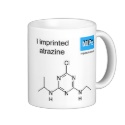|
|
Reference type: Journal
Authors: Dana M, Lulinski P, Maciejewska D
Article Title: Synthesis of Homoveratric Acid-Imprinted Polymers and Their Evaluation as Selective Separation Materials.
Publication date: 2011
Journal: Molecules
Volume: 16
Issue: (5)
Page numbers: 3826-3844.
DOI: 10.3390/molecules16053826
Abstract: A bulk polymerization method was used to easily and efficiently prepare homo-veratric acid (3,4-dimethoxyphenylacetic acid)-imprinted polymers from eight basic monomers: 2-vinylpyridine, 4-vinylpyridine, 1-vinylimidazole, N-allylaniline, N-allylpiperazine, allylurea, allylthiourea, and allylamine, in the presence of homoveratric acid as a template in N,N-dimethylformamide as a porogen. The imprinted polymer prepared from allylamine had the highest affinity to the template, showing an imprinting factor of 3.43, and allylamine polymers MIP8/NIP8 were selected for further studies. Their binding properties were analyzed using the Scatchard method. The results showed that the imprinted polymers have two classes of heterogeneous binding sites characterized by two pairs of Kd, Bmax values: Kd(1) = 0.060 μmol/mL, Bmax(1) = 0.093 μmol/mg for the higher affinity binding sites, and Kd(2) = 0.455 μmol/mL, Bmax(2) = 0.248 μmol/mg for the lower affinity binding sites. Non-imprinted polymer has only one class of binding site, with Kd = 0.417 μmol/mL and Bmax = 0.184 μmol/mg. A computational analysis of the energies of the prepolymerization complexes was in agreement with the experimental results. It showed that the selective binding interactions arose from cooperative three point interactions between the carboxylic acid and the two methoxy groups in the template and amino groups in the polymer cavities. Those results were confirmed by the recognition studies performed with the set of structurally related compounds. Allylamine polymer MIP8 had no affinity towards biogenic amines. The obtained imprinted polymer could be used for selective separation of homoveratric acid.
Template and target information: homo-veratric acid, 3,4-dimethoxyphenylacetic acid
Author keywords: Molecularly imprinted polymers, homoveratric acid, molecular modeling, molecular recognition
|


 multi MIPs tote bag
multi MIPs tote bag







 MI cryptic logo mousepad
MI cryptic logo mousepad







 Atrazine template mug
Atrazine template mug






